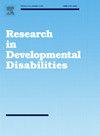The effect of Smart-Glove exchange-based system vs. PECS® on communication initiation in minimally verbal toddlers with autism spectrum disorder
IF 2.9
2区 医学
Q1 EDUCATION, SPECIAL
引用次数: 0
Abstract
Children with autistic spectrum disorders (ASD) show low engagement and priority of video over other activities. The Smart-Glove system is an augmentative and alternative communication tool combining video visual scene display (VVSD) with a picture exchange-based approach. This study compares the effectiveness of integrating Smart-Glove during PECS® phase 1 instructional strategy to teach independent initiation in minimally verbal toddlers with ASD. Four participants who failed to master PECS® Phase 1 over eight months at a specialized daycare were included. An alternating treatment design evaluated the relative effectiveness of Smart-Glove (VVSD and cards) versus cards only during PECS Phase 1 instruction. Percentages of independent request initiations, reaction times (RT) and social validity inventories were measured. Participants demonstrated improved independent initiations in both intervention sessions, with instances of 90 %-100 % successful independent exchanges. However, during Smart-Glove sessions, significantly higher average independent initiation, a faster learning linear trend and reduced RT reductions over time were achieved. Social validity inventories indicated satisfaction with the Smart-Glove system. Use of the Smart-Glove system improved independent request initiations, accelerated learning and increased reaction speed among minimally verbal toddlers with ASD, suggesting that integrating VVSD into PECS may be a motivational and effective instructional strategy for this subgroup.
求助全文
约1分钟内获得全文
求助全文
来源期刊

Research in Developmental Disabilities
Multiple-
CiteScore
5.50
自引率
6.50%
发文量
178
期刊介绍:
Research In Developmental Disabilities is aimed at publishing original research of an interdisciplinary nature that has a direct bearing on the remediation of problems associated with developmental disabilities. Manuscripts will be solicited throughout the world. Articles will be primarily empirical studies, although an occasional position paper or review will be accepted. The aim of the journal will be to publish articles on all aspects of research with the developmentally disabled, with any methodologically sound approach being acceptable.
 求助内容:
求助内容: 应助结果提醒方式:
应助结果提醒方式:


